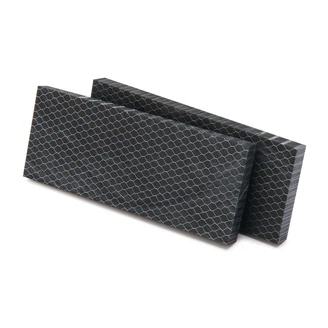When it comes to crafting or customizing knives, one of the most important decisions you’ll make is selecting the right knife scales. Knife scales, which form the handle of the knife, influence not only the knife’s functionality but also its appearance. Whether you’re a professional blade maker or a hobbyist looking to build your own knife, choosing the right handles for knives is crucial for both durability and style. The material you select will affect the knife’s comfort, strength, and overall aesthetic, making it essential to understand your options before deciding.
Understanding Knife Scales
Knife scales are the two pieces of material that cover the parts of the knife, creating the handle. They are typically made from a variety of materials, each offering different properties in terms of grip, durability, weight, and visual appeal. The choice of knife scales can transform an ordinary blade into a personalized, functional tool. There are many types of materials to choose from, such as wood, plastic, synthetic composites, and more.
Key Features to Look for in Knife Scales
When selecting, several key factors should be kept in mind to ensure you choose the best material for your specific needs. These features will influence not only the look of the knife but also its practicality and longevity.
1. Durability
Durability is an essential consideration when selecting knife scales. You want a handle that will withstand years of use without showing wear and tear. Some materials are naturally more durable, such as stabilized wood or synthetic resins, while others like traditional hardwoods may require more care and maintenance to prevent damage.
2. Grip and Comfort
The grip of the handle is just as important as the blade itself. A well-designed handle provides comfort during use, especially for tasks that require precision or long hours of handling. Materials like rubberized or textured handles can provide superior grip, even in wet conditions. On the other hand, smoother materials like bone or polished wood may require extra attention to avoid slipping.
3. Weight and Balance
The weight and balance of the knife depend largely on the scales used. A heavier handle can help balance a longer or heavier blade, while lighter scales can make the knife more agile. If you’re looking for a tool that feels balanced in your hand, take into account the weight of the handle relative to the blade.
4. Aesthetic Appeal
While functionality is key, the look of the knife also matters. Some users prioritize the aesthetic quality of their knife, opting for wood with unique grains or intricate patterns. Materials like carbon fiber, G10, or exotic hardwoods allow you to create a knife that not only works well but also looks stunning.
5. Maintenance and Care
Depending on the material of the knife scales, maintenance can vary. Wood handles often require oiling and care to maintain their appearance and prevent cracking or drying out. Synthetic materials, on the other hand, are often more durable and require minimal upkeep. Understanding the care requirements for your chosen material will ensure the longevity of your handles for knives.
Popular Materials for Knife Scales
Choosing the right material for your knife scales is a matter of both practicality and personal preference. Let’s explore some popular options available in the market:
- Wood: A classic choice, wood offers a natural look and feel. Hardwoods like maple, walnut, and oak are popular choices due to their strength and aesthetic qualities. For an extra layer of protection, you can opt for stabilized wood, which is treated to enhance durability and resistance to moisture.
- G10: This is a fiberglass-based composite material known for its strength and resilience. It’s lightweight, durable, and resistant to moisture, making it ideal for outdoor knives or those exposed to tough conditions.
- Micarta: Made from layers of fabric or paper impregnated with resin, Micarta is another durable material that can withstand harsh use. It’s also known for its excellent grip, which makes it popular for tactical and hunting knives.
- Carbon Fiber: For a sleek, modern look, carbon fiber is an excellent choice. It’s lightweight, incredibly strong, and adds a touch of sophistication to any knife. However, it tends to be more expensive than other materials.
- Plastic and Resin: These materials are cost-effective and come in a variety of colors and designs. They are generally more lightweight and offer a good grip, though they may not be as durable as G10 or wood.
Tips for Choosing the Right Knife Scales
- Consider Your Use: If you plan to use your knife for outdoor activities or heavy-duty tasks, you may want to opt for a tougher material like G10 or Micarta. For a kitchen knife, something comfortable and elegant like wood might be more suitable.
- Think About Maintenance: If you prefer low-maintenance options, go for materials like G10 or Micarta, which don’t require frequent care. Wood may need regular oiling to maintain its appearance.
- Balance Between Style and Functionality: While it’s tempting to choose materials based solely on aesthetics, always make sure the material you choose is practical for your knife’s intended use. Comfort and grip should never be sacrificed for looks alone.
Crafting a Custom Knife with the Perfect Handle
Once you’ve selected your knife scales, the next step is to attach them to the tang of your knife. This process can be done using screws or rivets, and it’s essential to ensure the scales are securely fastened. Customizing the knife scales can be a rewarding experience, allowing you to create a truly unique and personal tool. You can even mix and match materials for a one-of-a-kind design that reflects your personal style.
Craft Your Knife with the Perfect Handle
Selecting the right knife scales is a critical decision that impacts both the functionality and style of your knife. By considering factors like durability, comfort, weight, and aesthetics, you can choose the perfect handles for knives that meet your needs. Whether you prefer the elegance of wood or the strength of composite materials, there are countless options available to ensure your knife is as functional as it is beautiful.
For premium knife-making materials, consider exploring Woodcraft’s extensive collection of knife scales. They offer a wide range of high-quality materials to bring your custom knife designs to life.






